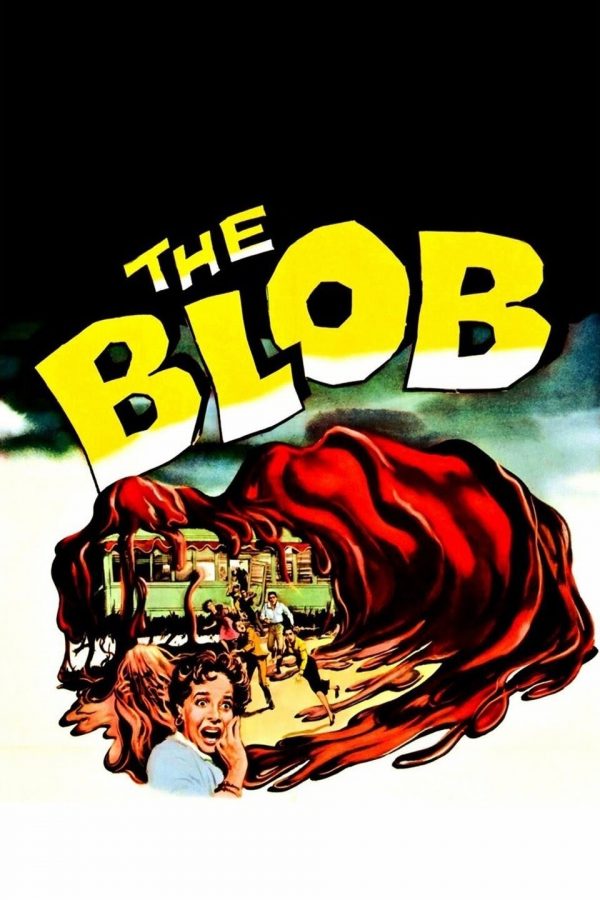REVIEW: “The Blob” crawls its way into the hearts of old and new generations
The Fantastic Fifties: an era memorialized by milkshakes, Rock & Roll, and the occasional extraterrestrial gelatinous creature that absorbs everything in its path.
March 1, 2021
Something sinister has seeped its way into the heart of a small Pennsylvania town when two young lovers discover that a gelatinous alien life form has broken loose as it begins spreading throughout the town amassing in size. With townsfolk slowly dissolving one by one, it’s up to them and their friends to convince the rest of the town that there’s a murderous ooze on the loose, or else it’ll be too late.
“The Blob” (1958) is a Sci-Fi/Horror film directed by Irvin Yeaworth and originally debuted as part of a double feature alongside “I Married a Monster from Outer Space.” The film also featured an opening title theme dubbed “The Blob” by Grammy and Academy Award-winning song artist Burt Bacharach.
Steven McQueen stars in his first feature film as Steve Andrews, a young bumbling teen out on lovers’ lane with co-star Aneta Corsaut as Jane Martin, the reserved but thoughtful girlfriend. The two of them set out to find a shooting star that had crashed miles away.
An old man (Olin Howland) encounters the fallen meteorite first revealing a resilient gelatinous creature rests inside and latches itself onto his hand. The two lovers take him to the town’s doctor (Stephen T. Chase) who succumbs to the creature soon after.
As they set out to warn Lieutenant Dave (Earl Rowe) and the rest of the police about this growing threat. To Steve’s avail, no one believes his cries of wolf, all the while the blob continues growing in size and liquifying the town’s folk one by one.
Steve and Jane quickly realize that they must gather the help of their friends to save their town from a creature who doesn’t think, doesn’t breathe, and only lives to devour everything in sight.
The film depicts an amorphous all-consuming blob as its main antagonist, yet one could argue that the true villain is time itself.
While the film once stood tall as an iconic staple of the giant monster genre of the ‘50s, with references and tropes that are still prominent in other works of media to this day, it has gradually become dated over time with certain sequences not aging well.
However, these dated sequences are mostly due to the film’s low budget which consisted of around $240,000.
As it was filmed in the ‘50s, special effects at the time were very costly, so the film crew cleverly used film techniques like cel animation, an art form which many cartoons in this era were painted frame by frame and building models which would lend credit in making the blob appear realistic in its breakout scenes.
Viewers are welcomed to a film that heavily relies on its dialogue and larger cast which helps to ground it. This quickly becomes one of the picture’s biggest strengths as a majority of the cast is well deservingly fleshed out. They’re each given a moment to shine as they try to outsmart and outmaneuver this terrifying creature
A major criticism to be made is that of the love interest’s role in the film. Corsaut’s character is often forgotten about in the very scenes she’s prominent in. She’s cast as the main character’s girlfriend, yet has very little to do as a character.
Larger scenes that involve multiple characters often have little dialogue with her and at times they outright ignore her. The actress’s name is even misspelled in the opening title credits.
Though the blob itself has a minimal amount of screentime due to budgetary constraints, this only helps to add more to the terror as viewers can’t help but continue watching as we see it creep ever so slowly knowing what horrors are in store for our unsuspecting victims.
For a film that came out during the late 1950s, an era in which low budget movies were being produced left and right to compete with each other at the box office, it still stands its ground amongst them as an unforgettable drive-in classic that helped to usher in the modern horror genre.
Daniel Pineiro is a contributing writer for the University Press. For more information regarding this or other stories, email dpineiro2015@fau.edu or @Danny_x101 on Instagram.







